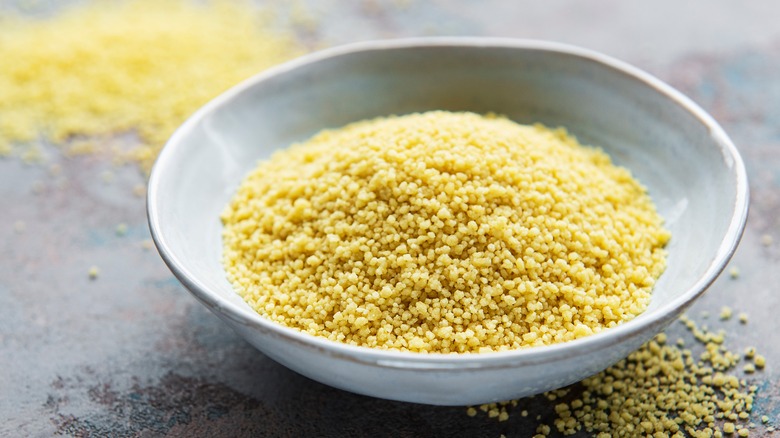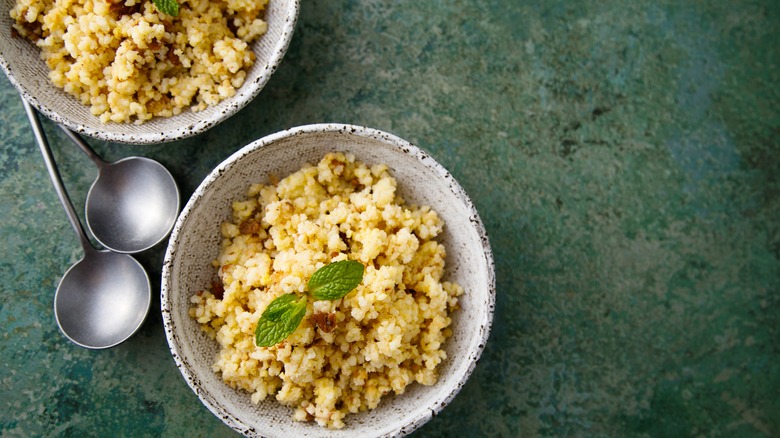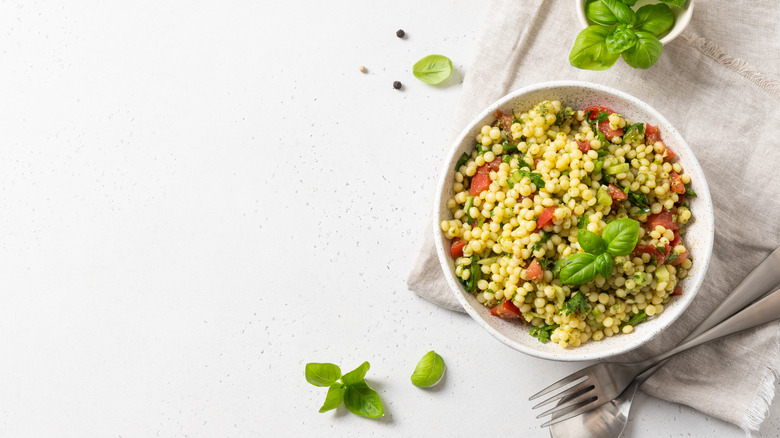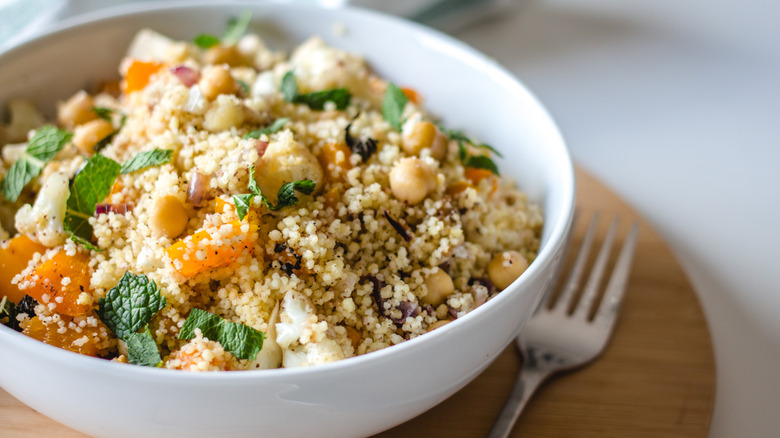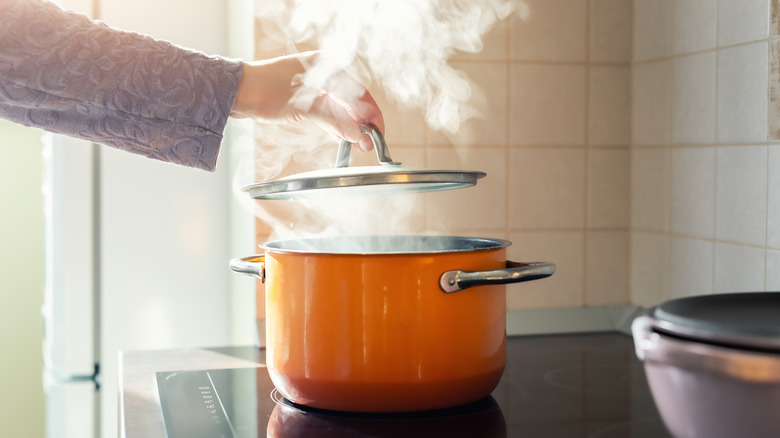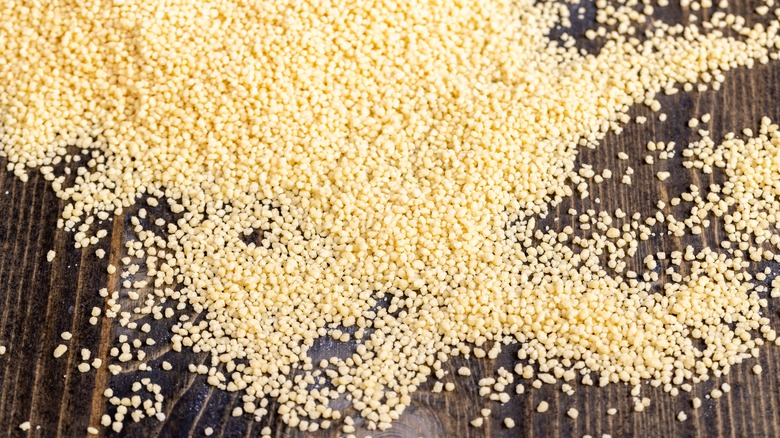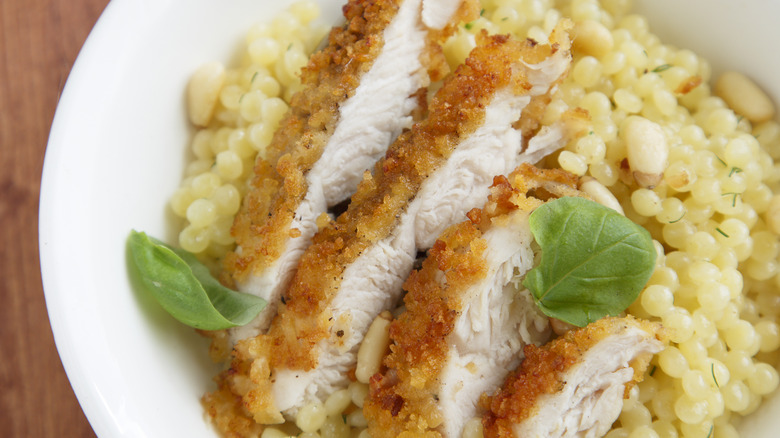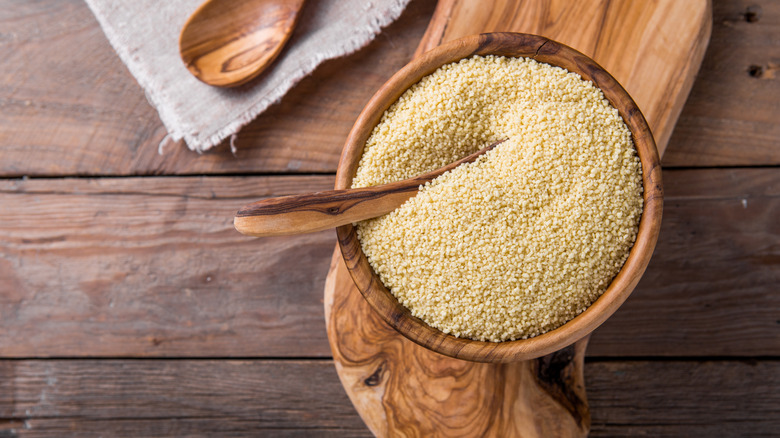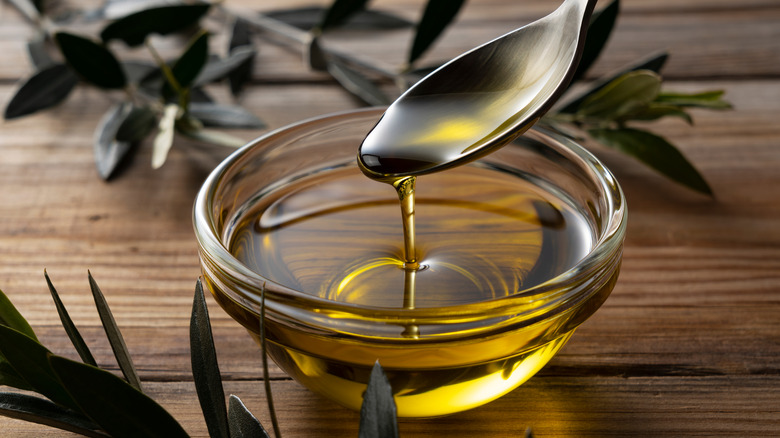10 Mistakes You Need To Avoid When Cooking Couscous
We may receive a commission on purchases made from links.
Foods don't get much cuter than couscous. A staple carbohydrate across the world, couscous is a simple, versatile base for a variety of dishes, and these teeny-tiny balls of semolina flour are as affordable as they are visually appealing. Often confused for a grain, couscous (which is available in the United States in several different varieties, most frequently from countries in North Africa and Western Asia) is actually made with durum wheat semolina, and is considered by some to be a form of pasta. And despite looking similar to some types of rice and quinoa, couscous is prepared and served in its own unique style (via Healthline).
One of the best things about couscous is that making it is often as easy as simply adding some liquid and waiting. And yet, for such an easy-to-prepare food, cooking couscous can go wrong fast. Anyone who's ended up with waterlogged couscous balls or bland mouthfuls of semolina will know that this is a food that requires a little technique, and we wanted to put a stop to the rookie errors that can plague couscous preparation. So we put together a list of the top mistakes you need to avoid when making your couscous bowl. Join us as we right some culinary wrongs and help you ensure that you get perfect couscous every time.
1. Using the wrong amount of liquid
Once you nail your pasta-to-liquid ratio when preparing couscous, you should end up with perfectly cooked grains every time. But to do that? You need to follow the formula, folks. Luckily, all it takes is a bit of measuring.
The basic ratio for couscous to liquid is 1 to 1.5, meaning that for every cup of couscous you use, you'll need to add one and a half cups of liquid. This ratio remains the same no matter what cooking method you're using, be that preparing it in the microwave or simply pouring water from a recently boiled kettle onto your couscous pearls.
Bear in mind that this is the ratio required for Moroccan couscous, arguably the most popular variety in America, and not other couscous types. It's also useful to remember that the ratio may vary depending on the brand you buy, or simply due to your personal preference of the done-ness of your couscous. Some couscous makers, like Bob's Red Mill, recommend using slightly less water to prepare their couscous, stating that you need 1.25 cups of liquid for each cup of couscous used. To find out what works for you, a little trial and error may be required, but the most important thing is not to drastically exceed the 1 to 1.5 ratio, as you'll just end up with waterlogged, unappetizing couscous. And remember, unlike other types of pasta, those tiny balls of couscous are a nightmare to drain.
2. Cooking different types of couscous in the same way
It's easy to assume that all couscous is made (and cooked) the same, but that's far from the case. Couscous comes in a few distinct varieties, distinguished by the size of the semolina shapes. There are three main types of couscous, each coming from a different country. Moroccan couscous is the type that many people in the United States might think of first, and is the smallest of the varieties, as Bob's Red Mill explains. Israeli couscous comes in a slightly larger form, with the semolina pearls designed to be created by a machine for mass consumption, and is often referred to as pearl couscous (per Masterclass). Lebanese couscous is the largest of the three types, with each piece around the size of a pea, and works well in stews and casseroles, says Woodland Foods.
Because each of these varieties is a different size, they cook in different ways and at different times. Moroccan couscous, with its tiny pearls, is typically cooked by adding hot liquid, covering, and giving the semolina time to soften and plump up (via The Frederick News-Post). As Israeli and Lebanese couscous is slightly larger, simply soaking them may not be enough to cook through to the pearls' center, so you may need to simmer the balls in hot liquid. Lebanese couscous will generally take longer to cook than Israeli couscous, as it's bigger. Whatever couscous variety you opt for, though, make sure that you're checking the package instructions.
3. Forgetting to give it time to rest
We all need a little rest, and couscous is no different. Giving couscous time to kick back and relax once you've added hot liquid to it is essential to its cooking process, and the overall success of your dish. Allowing it to rest properly, like rice, gives the pearls time to soften properly as the liquid and steam continue to work their way into the semolina. The result is a soft, pillowy bowl of couscous that isn't grainy or still tough in the middle.
So, how long should you rest your couscous for? The good news is that it won't take long. After you've added the liquid to your couscous and stirred it, you should leave it to rest for at least five minutes, as Good Cheap Eats states. Make sure that it's covered while it's resting so that the heat from the liquid can't escape, and that you're using a big enough dish, as the couscous will expand while it absorbs the water.
Then, once it's fully rested, there's one final step: Fluffing. If you don't fluff your couscous after cooking it, you run the risk of your pearls sticking together in a clumpy mass. Luckily, fluffing couscous is as easy as cooking it. All you have to do is take a fork and give it a good stir, separating the semolina balls from each other.
4. Using boiling water to cook Moroccan couscous
Moroccan couscous, with its tiny pearls of semolina, makes a great base for many meals, its fine texture providing a satisfying mouthfeel. But because it's so small, cooking it even just a little too enthusiastically can cause a big change. If you try to boil couscous instead of adding hot water and leaving it to soak, these semolina pieces can break down and coagulate into a clump of semolina flour, according to Plant Based School.
It's worth bearing in mind that many brands of Moroccan couscous are pre- or partly cooked, so they don't require the same constant high heat that some types of dried pasta do. Adding boiling water to the couscous may also cause it to clump. The best thing to do is to bring a kettle to a boil, allow it to cool slightly so that it's just under the simmering point, and then add your liquid to the couscous in a heatproof dish. Leave the couscous balls to absorb the liquid before fluffing, dressing, and serving. Make sure that you don't leave your water to cool for too long as well, as Yummly states. If you do this, the couscous won't absorb the water properly, and you'll end up with an undercooked, gritty texture.
5. Using the wrong dish to cook your couscous
You can nail your couscous-to-liquid ratio, season your pearls perfectly, and have your cooking timer set for the ideal number of minutes –- but if you're using the wrong dish to cook your couscous, all of that hard work is for nothing. The first thing to do is to make sure your dish is heatproof, as one that isn't built to withstand near-boiling water can crack when it comes into contact with hot liquid. This will not only make a serious mess, but can also be incredibly dangerous. It's best to avoid especially thin bowls, which may crack more readily, as well as plastic or metal bowls, which can warp or melt, states KitchenCuddle.
However, just any old heatproof dish isn't quite enough for perfect couscous. The shape is also crucial. If you're using a bowl that's too deep, it can create an inconsistent result, with weight and gravity cooking the couscous irregularly. Instead, try to use a shallow dish, as Yummly suggests. By doing this, you can make sure that some of your couscous isn't being pressed down by the pieces on top, and that each pearl has the space it needs to fully expand.
6. Seasoning incorrectly
You can have the best quality food on the planet, but unless you season it correctly, something will always be missing. And that's as true for carbs like couscous as it is for anything else. Ideally, you should season your couscous while it's still warm, states La Cucina Italiana. This will help your seasonings incorporate properly instead of just sitting on top of the pearls, and will also prevent you from coating cold clumps of couscous. Make sure that you mix your seasonings through the couscous thoroughly to ensure they reach every piece.
Remember, too, that couscous also needs a little oil to help it pop –- but it's easy to go too far. Adding too much oil can reduce your meal to a greasy mess and weigh down the couscous, eliminating the lightness that's so important to the carb's appeal. It's not only oil that you can use too much of, though, but all seasonings. Couscous may have a delicate, subtle flavor, but that flavor is what makes it so moreish. By weighing it down in an abundance of seasonings, you end up with a heavy meal that just tastes too strong (per Cooked Best).
7. Cooking it solely with water
There's nothing worse than bland food (okay, there are lots of things that are worse than that, but you know what we mean). And if you've ever felt that you've seasoned your couscous to perfection, taken a bite, and still felt like it's missing something, we think we know why.
Cooking couscous using water may be easy, but it's the quickest way to make your meal tasteless. By using a stock or a pre-seasoned liquid, you can ensure that flavor makes its way to every pearl, and as the liquid soaks into the couscous and plumps it up, the seasoning will get inside it too. You know how people salt their pasta water? Well, it's kind of the same principle, folks. Additionally, using stock will heighten the natural flavor of the couscous. You don't have to overcomplicate things here: A simple stock with a few spices thrown in can work wonders. In a pinch, you can also simply add salt to your hot water before pouring it into the couscous, which will give your grains a little boost.
8. Forgetting to choose whole-wheat couscous
Just as there is whole-wheat pasta, bread, and cereal, there's whole-wheat couscous too. And by foregoing the whole-wheat version, you may be missing out on a world of goodness. Whole-wheat couscous is an even more nutritious form of the carb, with higher amounts of fiber in each bite since the entire grain is included (per BBC Good Food). This fiber has a wealth of nutritional benefits, not only keeping you fuller for longer but aiding your digestive health. Whole-wheat couscous may also give you slightly more protein per serving, and slightly more iron than the equivalent amount of the refined type, states WebMD.
Opting for the whole-wheat version can give your meal an added taste kick too, with whole-wheat products often tasting slightly nuttier and more complex, as Livestrong explains. Happily, whole-wheat couscous usually doesn't need any additional steps when it comes to cooking, and you can sub it in for regular couscous without any change to the amount of water or time needed (via Tablespoon).
9. Forgetting to add oil while cooking
You know how people add oil to pasta water to stop the pasta from sticking together in the pan? Well, we really should be doing the same with couscous. And if you've ever ended up with big lumps of couscous that don't separate easily, it could be down to a lack of fat.
While putting oil in pasta water actually may not make that much of a difference, with couscous it's essential. Fat added to the cooking liquid will stop your couscous from sticking together, and when it comes to fluffing it up afterward, the pearls should come apart with little effort. The good news is that you can add oil either before or after cooking, as BBC Good Food explains. By coating your uncooked couscous in oil beforehand, the pieces will stay separate while they cook, while adding it afterward will help them fluff up nicely. If you're putting the oil in after, though, make sure to add it while the couscous is still warm. If you wait until it's cold, the pieces will be harder to break apart, and you may just end up with big oily lumps of semolina flour.
10. Leaving it too long before dishing up
Every chef worth their salt knows how important it is to prep ahead of time to avoid a last-minute panic in the kitchen. But when it comes to couscous, you don't want to make it too far in advance. While just-cooked, warm couscous can be the perfect fluffy accompaniment, if you let it go cold, it'll start to stick together, explains Yummly.
It's also important not to leave your couscous for too long before serving for safety reasons. Allowing couscous to sit at room temperature for more than a few hours can increase the risk of food bacteria taking hold, and potentially making your meal hazardous to eat (via Woman & Home).
And while refrigerating your couscous is totally fine, you should always wait until it's cool to do so, and reheat it before serving, to help the pearls separate again. To do this, place your couscous in a microwaveable dish and add a few tablespoons of water, says Near East. Stir the water through the couscous and then nuke it for a minute or two until it's warmed through. The added water will replace any moisture that's been lost while it was in the fridge, and help it to fluff up once more.
